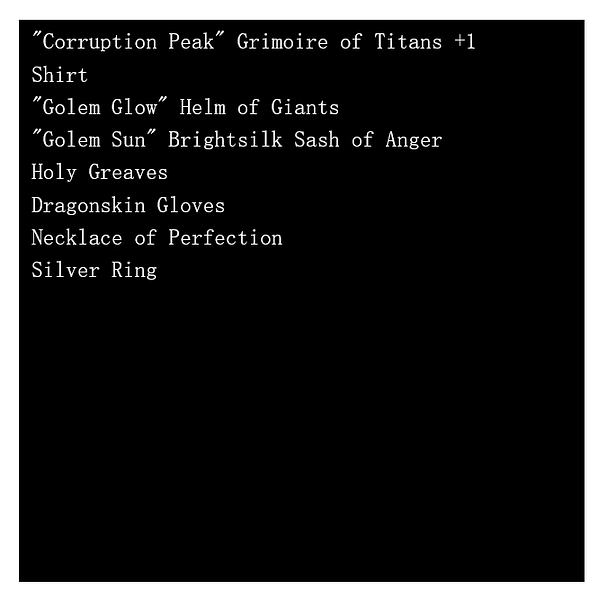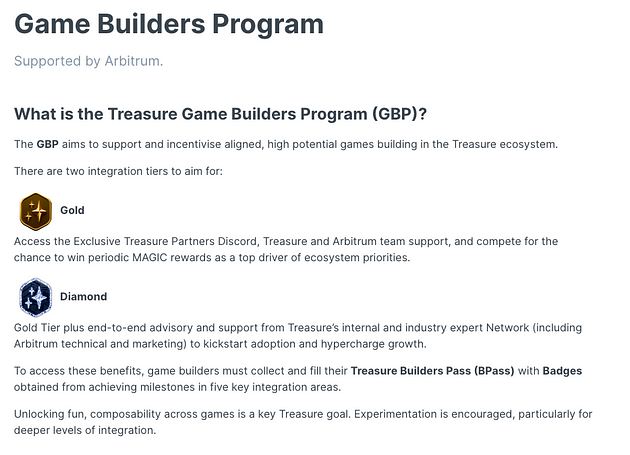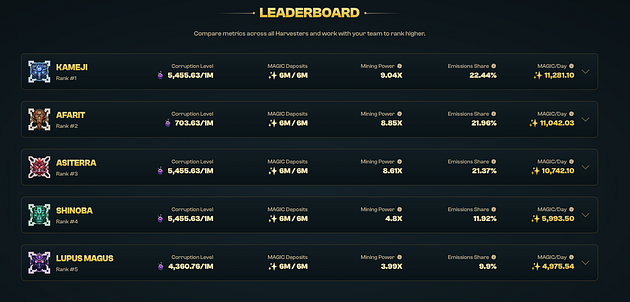
Winds Of Change: Web3 Gaming Heading to a New Frontier?
Tokenomics paradigm shift and insights from TreasureDAO

1. Introduction
Along with the recent recovery of the market, the Web3 gaming sector has also attracted the attention of the market with major updates of related projects. In particular, the rise of GALA Games (GALA), which continues to grow quantitatively through movie production and game studio acquisitions, and TreasureDAO (MAGIC), which received a lot of traction due to the success of the roguelike action RPG ‘The Beacon’, have been tremendous.
I personally believe that we are seeing a paradigm shift in Web3 gaming projects, not just in terms of price, but also in terms of structural improvements and changes. As the Play to Earn (P2E) system has been criticized by many for its instability, Web3 game projects are in the process of finding the optimal structure, including tokenomics, through many efforts, especially with a focus on sustainability. In the following, we’ll take a look at how Web3 game projects are changing and what insights we can learn from them.
2. A paradigm shift in tokenomics
2.1. Past discussions of game tokenomics
Since the advent of Axie Infinity, the tokenomics of Web3 games has been characterized by the number of tokens associated with the game. Since the dual token economy model of Axie Infinity, game projects have emerged with different types of tokenomics models, and as the discussion of tokenomics design continues as a way to address sustainability issues in Web3 games, there has been a lot of debate about which model is best suited to run Web3 games.
The chart above is a comparison of the tokenomics of Crabada, Axie Infinity, and DeFi Kingdoms published by The Block Research, and was presented in the context of the debate on the optimal gaming tokenomics after the SLP token price plunge (published in March 2022). However, it’s interesting to note that the original author, Erina Azmi, commented in a Twitter thread that “how many tokens exist in a gaming ecosystem” is not relevant to the instability of Web3 games.
7/ Consider Axie Infinity.
— Calmdonut (@_calmdonut) April 7, 2022
SLP oversupply began in July 2021, and the only way to balance it is through breeding activities in which SLP is burned.
Breeding is the ONLY SLP sink, that ultimately depends on people buying more Axies. pic.twitter.com/8jrZErd852
Azmi claimed that the plummeting price of SLP tokens was due to operational inexperience on the part of Axie Infinity, which didn’t start dealing with the issue until six months after the oversupply problem occurred.
Further pointing out the idea that tokenomics consisting of single, dual, or triple tokens doesn’t matter, but rather emphasized the importance of a “faucet and sink” mechanism.
2.2. Categorizing tokens by role
I agree with Erina Azmi that categorizing tokenomics models based on the number of tokens is not effective. Instead, I think it would be more effective to categorize tokens (hereafter referred to as fungible tokens) in terms of their role, and to develop a discussion based on that criteria. The classification criteria can be simply divided into two categories: in-game tokens and governance tokens.
In-game tokens
- Primarily used as in-game currency to power in-game interactions.
- Example: SLP token in Axie Infinity
Governance tokens
- Serve as governance participation, funding and reward vehicles, staking incentives, etc.
- Example: AXS token in Axie Infinity
2.3. Sources of instability: In-game tokens
According to data provided by Nansen, SLP tokens have been oversupplied since September 2021. As mentioned in our previous article, in Web3 games where NFT breeding is a key gameplay element and in-game tokens are used as breeding materials, when the demand for NFT decreases, the number of users selling tokens on the market increases and the price of tokens plummets.

This phenomenon can be interpreted as originating from the following features of in-game tokens.
- Earned through PvE play: Players can earn tokens by putting in a certain amount of play time without any requirements, which can be abused as a way to earn tokens by multiple accounts or bots.
- Openess: not limited to the in-game ecosystem and interacted with in an open environment where anyone can buy and sell.
For the sustainability of the game, it is essential to continuously maintain an affordable price by adjusting the net issuance of in-game tokens, but due to the above features, it is almost impossible to promote sustainability through the design of “faucet and sink” mechanism.
2.4. Lack of necessity of in-game tokens
In order to promote the sustainability of in-game tokens, Web3 game projects have introduced various solutions, such as limiting the outflow of in-game tokens outside the ecosystem (Mir4 Global), operating the in-game token swap pool on a private chain to exclusively operate the liquidity supply (Bora Chain), and continuously using a portion of the game’s revenue to buy back in-game tokens (Archeworld).
However, the act of adjusting the issuance and price of in-game tokens through these solutions raises questions about the necessity of in-game tokens. Artificially limiting the features of in-game tokens for the sake of sustainability makes it difficult to find a particular justification for their application compared to the option of operating Web3 games through off-chain currency.
3. Updates and Implications for Web3 Games
3.1. Axie Infinity
Axie Infinity has sparked a Web3 gaming phenomenon in the market, prompting many projects to adopt a “dual token economy”. But at the same time, it also showed the sustainability problems of P2E games due to the rapid fluctuation of SLP token prices. Recognizing these issues, in February 2022, ahead of the start of Season 20, Axie Infinity made the following in-game economic balancing changes.
Closing the path to SLP tokens through PvE play
- Over 55% of the existing daily issuance of SLP tokens was coming from PvE play (Adventure mode and quest completion).
- The project will block SLP tokens from being earned through PvE play and will only allow SLP tokens to be earned in-game through game win rewards.
Expanded PvP Competitive Rewards Utilizing AXS Tokens
- Axie Infinity has been rewarding AXS tokens based on player ranking at the end of each season.
- In Season 20, we dramatically expanded the reward pool, rewarding the top 300,000 players with approximately 117,000 AXS tokens.
- Compared to the previous season, Season 19, where we awarded 3,000 AXS Tokens to the top 1,000 players, this is a significant increase in rewards.
It can be interpreted the direction of the update as an effort to minimize the role of SLP tokens as “player rewards” and shift that role to AXS tokens, while maintaining roughly the same amount of in-game issuance and burning to address the issue of oversupply or overdemand for these tokens. In fact, the chart below (source of Nansen) shows that the net issuance of SLP tokens has slowed down considerably since the update.
3.2. Town Star
Town Star, a strategy simulation farming game by Gala Games, is another example of a Web3 game that utilizes in-game tokens. Similar to Axie Infinity’s SLP token, players can earn more TOWN tokens by spending more TOWN tokens and utilizing quality NFTs in their gameplay. Under this structure, the price of TOWN tokens soared up to around $2.1 after the token’s launch, but after continued price declines, the price reached a level below $0.02 in July 2022.
On July 19, 2022, Town Star announced in a blog update that it would stop issuing all TOWN tokens as play and node rewards. This was the first major update to the in-game economy since the company hired renowned game creator Mark Skaggs as an in-game economy expert in June 2022. Since then, the game has run P2E competitive reward weeks once or twice a month, with rewards in GALA tokens or in-game NFTs instead of the TOWN token rewards. Finally, in January 2023, Town Star announced that all TOWN tokens would be merged with GALA tokens at a 2:1 ratio, signaling the end of the TOWN token (related article).
3.3. Conclusion I
There is no exaggeration to say that Axie Infinity and Gala Games are two of the leading Web3 gaming projects. The updates above show that both projects are taking steps to reduce or even eliminate the role of in-game tokens. This suggests the days of the “dual token economy,” which uses both “in-game tokens” and “governance tokens,” are numbered.
It can be described that there is a paradigm shift to a “single token economy,” which is more accurately described as a single token economy in terms of roles rather than number of tokens. Specifically, we can say that Web3 game projects are updating to reduce the role of in-game tokens that directly interact with the gameplay process and maximize the role of governance tokens. In this process, the role of governance tokens as player rewards is increasing, and in-game tokens are either being replaced by off-chain currencies altogether, or are being redesigned to minimize price fluctuations by inducing roughly equal amounts of in-game minting and burning.
4. Innovative Web3 gaming platform, TreasureDAO
TreasureDAO is a Web3 gaming platform that attracted market attention due to the success of “The Beacon”. An overview of TreasureDAO can be found in Declan’s “How MAGIC in Crypto Games Happens?”.
TreasureDAO still has a lot of room to improve in terms of game quality, but I personally evaluate TreasureDAO as the most innovative Web3 gaming platform so far. I’ll explain why I think so.
4.1. Crypto-friendly branding

Loot is a text-based, image-free NFT project that features randomized combinations of equipment lists found in RPG games. Participants in the Loot project created their own creations based on the text of each NFT, symbolizing the project as a participatory community-based value creation project. For a better understanding of the Loot project, please refer to Jason Ye’s article.
TreasureDAO launched their MAGIC token through a process of staking Loot NFTs and derivative projects like “n” and “AGLD” (related tweet). This distribution method helped to establish a connection between the Loot project and TreasureDAO. Additionally the fact that TreasureDAO is a native project of Arbitrum played a role in attracting people who were familiar with crypto culture, also known as “Degens”, to the TreasureDAO ecosystem. These efforts led to the development of a dedicated fan base for TreasureDAO.
4.2. Building Infrastructure: Focusing on Bridgeworld
TreasureDAO’s ecosystem includes three key components: MagicSwap, Trove, and Bridgeworld. MagicSwap is a decentralized exchange that enables game tokens from the TreasureDAO ecosystem to be paired with the MAGIC token. Trove is a marketplace that allows for the trading of all NFTs from games onboarded to the ecosystem using MAGIC as the single currency. Bridgeworld is a GameFi project that plays a crucial role in maximizing the utilization of MAGIC tokens, and its functions need to be described in detail.
4.3. First, the implementation of a staking strategy game
Bridgeworld can be seen as a MAGIC token staking strategy game, with the following features.
- Players can stake MAGIC and NFTs in the Atlas Mine or Harvester and earn MAGIC tokens.
- Utilize Legion NFTs to perform quests, earn NFTs for staking, or summon more Legions.
- The more MAGIC tokens you stake, the longer you stake, and the more variety and number of NFTs you stake, the more staking rewards.
- The amount of MAGIC tokens staked in the Atlas Mine or Harvester and the length of the lock-up period will grant gMAGIC, a vote in TreasureDAO governance.
Based on the above features, Bridgeworld can be considered a “Gamification of DeFi” or “GameFi” project. The gamification of token staking and the process of boosting through NFT acquisition and staking can be seen as an improved form of the GameFi service demonstrated by Defi Kingdoms. With the recent closure of Atlas Mine through governance (TIP23), MAGIC staking rewards can only be obtained through Harvester, which can be considered a more sustainable form of farming mechanism than Defi Kingdoms because 1) the maximum amount of MAGIC tokens that can be staked is fixed, and 2) Consumable NFTs with decreasing durability must be continuously acquired through gameplay to sustain the boosting effect.
Through this structure, Bridgeworld not only encourages the continuous participation of ecosystem participants including token holders in the form of on-chain transactions, but also applies such participation to the distribution of governance voting rights, ensuring that quality governance is achieved.
4.4. Second, Curve Finance in Web3 Games
The method of assigning varying weights to token rewards and governance votes based on staking duration is similar to Curve Finance’s veTokenomics. For a better understanding of Curve Finance, please refer to Jason Ye’s articles ‘Curve War 1’ and ‘Curve War 2.’
Aside from the weighted distribution of token rewards by staking period, TreasureDAO and Bridgeworld are very similar to the structure of Curve Finance. Before we get into the details, let’s briefly summarize the features of Curve Finance.
- A service that meets the needs of onboarding protocols: implementing AMMs to minimize slippage when trading between stablecoins.
- Replacing token inflation with staking incentives: competitive reward models drive sustained staking and governance participation.
- Protocols can directly compete for staking rewards and launch new services using them.
Curve Finance’s CFMM minimizes slippage in stablecoin-to-stablecoin transactions, which has attracted many stablecoin protocols to onboard with Curve Finance. The token inflation in the ecosystem became an incentive for participants to keep staking, earn more veCRV tokens, and participate in governance. The longer and more CRV tokens are staked, the more governance rights (veCRV) participants receive. Governance decisions determine which liquidity pool receives the daily CRV inflation, which is operated by the protocol. The staking system has not only encouraged protocols to compete for rewards but has also led to the emergence of new protocols like Convex Finance. These new protocols are designed to effectively utilize Curve Finance.
How similar is TreasureDAO’s structure to the characteristics of Curve Finance? First, let’s take a look at TreasureDAO’s onboarding protocol, which is a service that caters to the needs of Web3 games. First of all, the ability to use or benefit from TreasureDAO’s built-in infrastructure, Trove, MagicSwap, and Bridgeworld, is a big draw for Web3 game projects. TreasureDAO also has a Game Builders Program, which offers tiers of MAGIC token rewards and advisory support based on KPIs for games that are onboard the ecosystem.

Next, are they replacing token inflation with staking incentives? TreasureDAO does not have a mechanism to set the direction of token inflation through governance like Curve Finance. However, Harvester has a total of five staking pools, and the daily token emission share allocated to each pool is measured relative to the mining power of each pool. In addition, since the consumable NFTs involved in boosting staking rewards decrease in durability and disappear in proportion to the staking period, players participating in staking in each pool of Harvester have an incentive to continue playing the game, earning NFTs, and depositing them into the staking pool in order to avoid reducing their MAGIC token rewards.

Finally, in addition to individual participants, Bridgeworld will also be used by Web3 game projects that onboard the ecosystem to participate in competitive rewards and increase the value of their games through the staking infrastructure. While this approach is not adopted by all projects onboarded to TreasureDAO, BattleFly is an example of a project that actively utilizes Bridgeworld’s staking infrastructure.
BattleFly is a PvP strategy game onboarded to the TreasureDAO ecosystem where players stake a small amount of MAGIC tokens to play the game, and when they win a battle, they capture their opponent’s MAGIC. BattleFly directly participates in Bridgeworld play to earn MAGIC rewards and fill the project’s treasury, while also offering higher MAGIC rewards to players who enter their ecosystem through a device called “Flywheel,” which creates a demand for native tokens and NFTs in exchange for higher MAGIC rewards. Here’s how it works:
- Flywheel is a staking tool provided by BattleFly, where you can deposit your MAGIC to earn the same rate of return as staking on Bridgeworld.
- The following BattleFly native assets can be deposited together when staking to receive the same MAGIC rewards as those boosted by Harvester
- BattleFly Founders NFT
- gFLY token (BattleFly native token)
- gFLY:MAGIC LP tokens (available after providing liquidity on MagicSwap) - The boosted MAGIC rewards provided by Flywheel originate from the MAGIC rewards received by BattleFly for participating in Bridgeworld staking directly on their end.
In order for players to efficiently mine MAGIC tokens on Harvester, they need to consistently acquire a large number of NFTs, and with the maximum staking cap (6M MAGIC tokens per pool), staking as much MAGIC as they want is not easy. To capitalize on this aspect, BattleFly is using their own Bridgeworld assets to provide efficient MAGIC rewards to players who stake on Flywheel, and bootstrapping by creating demand for their assets.
Although this mechanism is different in form, it can be evaluated as similar to the case of Convex Finance, which operates a protocol business using Curve Finance.
4.5. Conclusion II
TreasureDAO is an excellent example of how a project can leverage native tokens to build a Web3 gaming platform. We can summarize the takeaways in three bulletpoints.
- Shape the project’s narrative and create a community through rewarding native tokens, leveraging branding strategies, and being an on-chain gaming platform.
- Maintain and engage the community by introducing staking strategy games, incentivizing token inflation, and tying it to governance.
- Onboard Web3 game projects by establishing a strong community and branding, providing infrastructure services, and implementing incubation systems.
By following the above, TreasureDAO demonstrates how to shape a project’s narrative and create a community, how to gain contineous engagement from the community, and how to onboard Web3 gaming projects into its ecosystem.
Although it may not be easy for other web3 game platform projects to replicate TreasureDAO’s success, there are valuable insights that can be learned from their actions. In terms of the next steps for TreasureDAO, Minebuu, the OG of TreasureDAO in Korea, shares some thoughts in a thread.
4.6. TreasureDAO’s ($MAGIC) Next Step Summary (created on December 16, 2022)
Source: Minebuu’s Cryptoball
- Onboarding more games: LifeForce, Kuroro Beasts, and others are expected to join, and the recent success of Beacon and Magic’s exchange listing will accelerate the arrival of these quality games.
- Creating its own games: TreasureDAO is working with a game studio called StriderDAO to create Smallville based on the Smallbrain IP, and will also be building its own TreasureDAO game studio. Just as Nintendo and Steam have exploded with exclusive games that are only available on their platforms, so too can Magic attract gamers from outside of its borders by creating its own games.
- Funding: The TIP-22 proposal currently being voted on is to monetize product revenues such as marketplace revenue and BridgeWorld revenue through Flowdesk, a legitimate marketmaker, on a non-market impact basis (up to 1–2% of daily volume). The capital will be used to keep the team running, expand the ecosystem, and open a game studio. By not relying on funding, we don’t have to deal with cheap tokens and have the potential for explosive growth with ongoing funding.
- Infrastructure: Becoming a Web3 Nintendo/Steam is not just about gathering a bunch of games, there has to be a factor for other games to join on their own. TreasureDAO is doing this with steady updates to the Trove exchange (quest/achievement/badge system, etc.), SDK support for the core product, a game builder incentive program, and increased interoperability between games.
- Arbitrum: The Treasure ecosystem accounts for 25% of Arbitrum’s transactions, and most Arbitrum games have a flow to join the Treasure ecosystem. The Arbitrum ecosystem has grown beyond Polygon, and if EIP-4844 significantly reduces Arbitrumm’s fees, other layer 1 games may migrate to Arbitrum.
5. It’s a token business after all
While the success of Axie Infinity in the crypto market has led to a boom in P2E projects, the success of WEMIX has driven many game companies to launch Web3 game platforms in the Korean market. The WEMIX platform’s utilization of WEMIX tokens, i.e., linking multiple in-game tokens onboarded to the platform and allowing players to secure and monetize ownership of those game assets, has become the dominant token utilization method for Korean Web3 gaming platforms.
However, as the sustainability of Web3 games is becoming increasingly challenged and in-game tokens are being abolished, the significance of platform tokens that simply serve as connectors between in-game tokens is becoming diluted. In this regard, TreasureDAO’s case sets a precedent by utilizing a single token called MAGIC to operate a Web3 business. The MAGIC token is used for 1) narrative formation and branding, 2) rewarding ecosystem participants for their contributions, 3) acting as a base currency for asset transactions within the ecosystem, and 4) paying grants to game projects. What other projects besides TreasureDAO have realized such a wide range of uses in a sustainable way?
I personally believe that tokens are an economic incentive for people to behave in a certain way, which is why they are almost inextricably linked to “governance,” which is the process of ensuring that people behave in a way that benefits the project that issued the token. In the gaming industry, ecosystem participants are often treated as customers rather than owners. As a result, the utilization of tokens has typically been limited to service rewards instead of empowering them as key players in the ecosystem. In this regard, we believe that the direction of TreasureDAO’s governance on platform operation and improvement has great implications for token utilization. For example, the recent community consensus of TIP23 governance to remove Atlas Mine, a static staking tool, in order to avoid a speculator-centric gaming platform, is one of the precedents set by ecosystem participants acting as operational actors rather than “owners”.

Web3 business boils down to token business. How will the token be utilized to what effect? I look forward to seeing how many people come up with novel and effective answers.
<References>
- Calmdonut, Twitter thread
- Axie Infinity, Upcoming Season 20 & Economic Balancing Adjustments
- Town Star, Town Star Economic Updates
- Playtoearn Online, GALA Discontinues $TOWN
- TreasureDAO docs
- Bridgeworld Master Game Guide
- BattleFly docs
- TreasureDAO commonwealth
- BattleFly, Introducing Flywheel 2.0 — Competitive Locking
- Minebuu’s Cryptoball